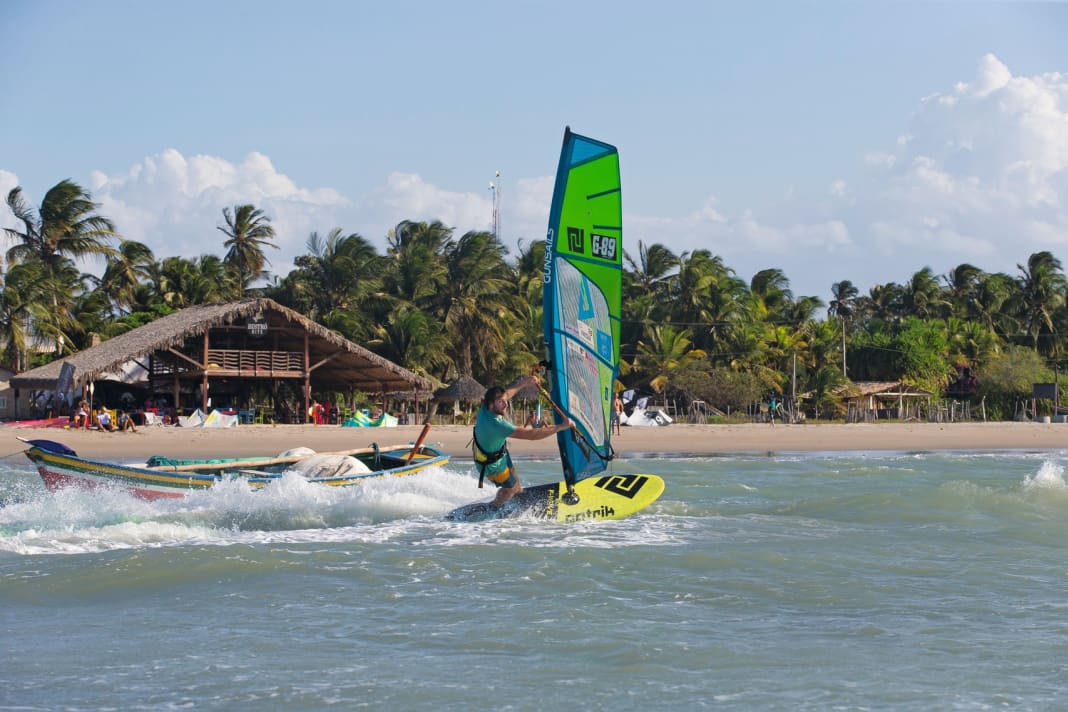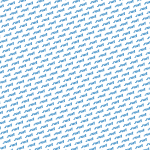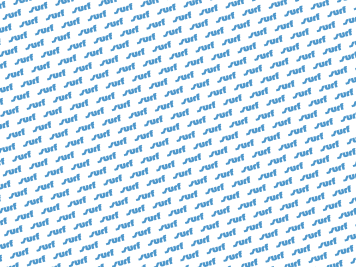Spots in this article
A windsurfing trip to dreamy spots with guaranteed wind? Is that possible? There is this - almost - wind guarantee from July to December at an almost infinite number of spots in Brazil north of Fortaleza, a city of three million inhabitants in north-east Brazil. However, any kind of "guarantee" in a South American country is risky. But Brazil has the raw material we need so urgently; the wind blows here every day in the second half of the year. On our first trip to Brazil with windsurfing globetrotter Dennis Müller two years ago, we visited the region from Cumbuco to Jericoacoara. On the outward flight, the question from Brazil newcomer Dennis about the wind forecast for the coming days was unforgettable. We just looked at each other and asked, "Why? We'll have more than enough wind every day!" Dennis looked at us as if we were pulling his leg, only to end up with a big grin on his face after the trip, because windsurfing every day from morning to night, where else can you find that? For our second travel report in north-east Brazil, we decided to head to the spots north of Jericoacoara.
Unfortunately, windsurfing in Brazil has so far only taken place at very few spots in the entire region; it is almost exclusively kitesurfers who have discovered the land of the "eternal" wind for themselves. And so we can hardly believe our eyes on our KLM flight from Amsterdam, because of the 180 or so passengers on the plane, there are easily 120 kiters and only a good handful of windsurfers.
We pull our board bags out of the airport and, in addition to the typical humid heat in this part of the country, Jeff, a Brazilian who speaks perfect English, welcomes us with the 4x4 pick-up we had already booked in Germany. Up onto the loading area with the bags and an app on the smartphone shows us the way north, more precisely to Maceió, the first spot on our journey.
It's another six hours' drive to the town, which is located far to the north, about 1.5 hours' drive north of Jericoacoara. Just 20 years ago, "Jeri" was only known to insiders and today the spot is overcrowded in the high season and the number of non-water sports tourists is now very high, as is the range of accommodation, restaurants and shops of all levels. And in Maceió? Exactly the opposite awaits us here.
Brazil: The best surf spots around Maceió

1 Maceió

We stand on the beach and look at the spot, the water conditions remind us very much of those in Jeri. The waves run upwind around a point and are "filleted" quite cleanly bit by bit. Then they run into the elongated bay in a clean and orderly fashion at good intervals with a maximum height of one metre. Further downwind, there are always new wave sections that are a little flatter, but just as spaced out. Particularly in the hours before and after high tide, the waves in the upper area are passable, just like in Jeri, the waves don't have too much pressure and aren't fast either. Around high tide there are good conditions for jumping. We experience a wind chop between the waves during our days on site, but this only becomes more pronounced from around 25 to 30 knots of wind. Towards low tide, the waves get smaller and you have to walk about 150 metres out to the water's edge.
Especially in November and December, the wind only starts during the morning and then picks up. At first it blows a little side-offshore and then shifts to sideshore as the morning progresses. However, the wind is not gusty over the windward headland, which is in clear contrast to the "on-off" wind conditions in Jeri. Even at high tide, there are no wind holes under land, at least during the day. There are a maximum of 15 windsurfers and maybe half a dozen kiters on the water, which is a rather small number in this region.
As soon as we arrive, we stop for a quick meal at "Do Fabrizio", the local Italian restaurant, and meet the world-class freestylers Amado Vrieswijk, Dieter Van der Eyken and Francesco Capuzzo, who are training and filming in Maceió. The world-class freestylers have travelled up here from Jeri for a few days for a good reason, as the conditions are also very special from their point of view. "It's very good for freestyling here, the spot is bigger than in Jeri and I can also go for it all by myself in the waves. The gaps between the waves are large and are ideal for practising new moves. The wind here is undoubtedly more consistent than in Jeri," Amado Vrieswijk tells us, "only the surroundings can't match the flair of Jeri!" It's clear what the year-old pro means, because while the party goes on every day in Jeri, there's nothing like that in Maceió. During the day, Gigi and Lasse's windsurfing centre and the Taverno do Fabrizio are the only meeting places on the beach.
Maceió develops into a Jeri alternative
Maceió offers around eight accommodations, of which the pousadas Vila Zen, Villa Mares, Morada do Sol and Coco Cabana offer a good standard. Another pousada is being built directly on the spot and we have heard from a German windsurfer who also wants to build a pousada on the beach here. The range of restaurants is also manageable. There are also a few "barracas" (Brazilian fish restaurants that are mostly frequented by locals at the weekend, the ed.) further south in the village.
One more thing to say. We spent the night in another pousada and managed to get two cockroaches out of our room and, in a concerted effort, were unable to catch a third, which successfully crawled into a crack in the room.
Maceió is a gem that is still relatively unknown in windsurfing circles, but this is guaranteed to change in the coming years. The windsurfing conditions and space on the water are too good, especially in relation to Jeri. At high tide, the spot is perfect for jumping and for anyone who wants to ride the waves and you won't get stressed by the waves, which are not powerful or fast enough to damage equipment. Surf beginners through to world-class freestylers feel at home here. There are better spots for those learning to jibe due to the waves. But if you're looking for parties and a wider range of restaurants and accommodation, you're in the wrong place, and Maceió won't be able to compete with Jeri in this respect in the future either.
2 Camocin

Fancy a bit of variety? Why not take a day trip to a spot with the finest smooth water conditions? It's a 20-minute drive to the town of Camocin. There, however, we have to take a small ferry to the other side of the river. After the two employees have seen our equipment on the loading area of the 4x4, they are delighted that windsurfers are once again populating the spot and give us a high five to say hello. They use their hands and feet to explain to us exactly where the best wind conditions are on the other side of the river, "you have to go there", and point to the right-hand side, a little way in the direction of the large sand dune. In fact, there are areas where the offshore wind blows without any significant turbulence. And the lower the tide, the smoother the water, allowing Dennis to pull off the finest freestyle moves and catch his best session on the freestyle board during our trip.
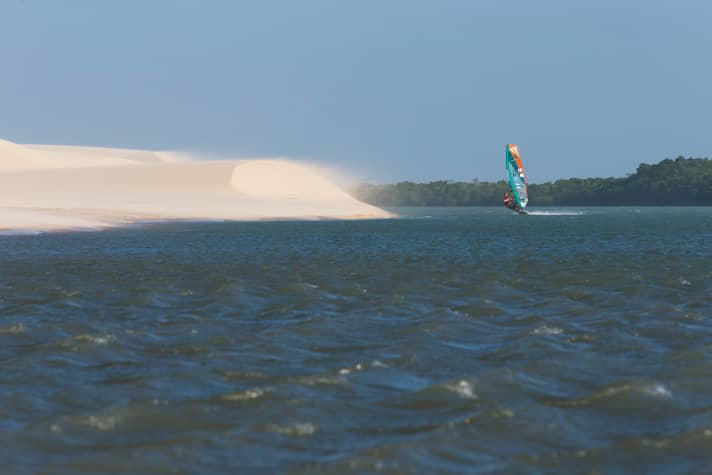
We enjoy the microwaves for a few hours, although they get bigger as the water rises, making them choppier. While the choice of places to eat in Maceio is still very limited, there is a larger selection of restaurants in Camocin. Gigi and Lasse, the owners of the Sa Barra windsurfing club in Maceio, also go to Camocin every now and then just for a bite to eat, of course, because after weeks at the windsurfing hotspot they are happy to have a change and get out and about. There are also supermarkets in Camocin, which stock a wide range of groceries and we can also buy fresh fruit and vegetables. There is also a pharmacy, a small hospital and a bank here.
Instead of travelling on the road, we head north along the beach from Maceio to our next destination, Barra Grande. For several kilometres, we see nothing but sand dunes up to 70 metres high, small fishing villages, water and, in some places, not a soul for miles. At a spot with smooth water - somewhere in the middle of nowhere - Dennis quickly takes out his equipment and does a fun freestyle session to cool down from the tour in the hot 30 degree air temperature. Perhaps this spot is just representative of dozens of other spots along our trip. Station manager Gigi and others keep telling us stories about "you should go there too ... great conditions ... smooth water ... waves ...". We then cross over a river by car and eventually end up in Barra Grande, the last spot in the state of Ceara.
3 Barra Grande

Straight out onto the water! At high tide, the sea is quite choppy, but it's good for having a lot of fun with a 5.2 sail almost alone on the water. The kitesurfers who live in Barra Grande almost invariably do a downwinder into a mangrove lagoon with very smooth water at high tide, only to be taken back up again in a donkey cart. Due to a tidal range of up to 3.5 metres, the spot in Barra Grande looks completely different at low tide. The sandy bottom is partially exposed, so that windsurfing is only possible further out about two hours before and after low tide.
At a party in the evening, we meet Jose, Managing Director of the Feel Viana Sporthotel in Viana do Castelo in Portugal, who not only comes here every year to surf, but also wanted to set up a windsurfing centre with JP/NeilPryde equipment in Barra Grande in September 2020 - but then coronavirus hit and the project has been put on hold for the time being. He tells us enthusiastically about the good windsurfing conditions for a broad audience, but due to the lack of centres, windsurfers usually have to let off steam alone on the water. There is almost unlimited space here.
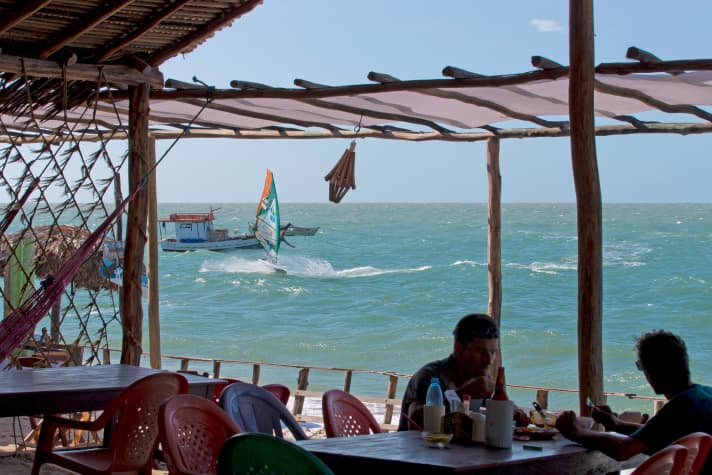
Barra Grande is already well developed as a tourist destination. Year after year, the number of lovingly made pousadas and restaurants is increasing and the streets are still made of fine sand, making the place seem fascinating to us. Our Swedish friend Thord, who is actually staying in a pousada in Macapá to the north, has moved to Barra Grande, "it's much nicer here and there's a lot more going on!" Two bars have now also established themselves in the town, so we can let the nights get short with caipirinhas in our hands.
4 Macapá

It's actually only a few kilometres to Macapá, but due to the estuary in between, we have to drive far inland - this time by road - making it a trip of almost an hour. Ten years ago, I visited Macapá for the first time, just across the border from the state of Piaui, and eight years ago we were still surfing almost alone on the water. Since then, the picture on the water and on land has changed a lot. Or to put it better, I almost didn't recognise the conditions at the spot because the wind, the waves and the tidal currents change the position of the sandbanks every year. And to such an extent that a road or an entire house has fallen victim to these sand movements at the water's edge. In the past, we have had excellent conditions around low tide and in November it is the hours before and after high tide when we have found the best water conditions.
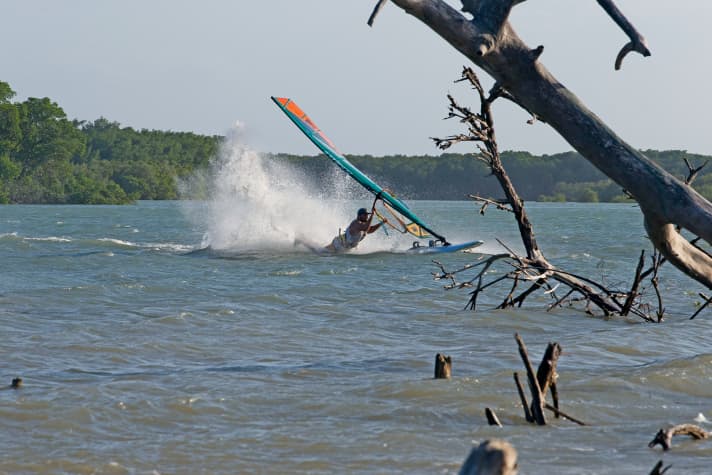
Dennis is out for a session of freestyling at high tide and is clearly having a lot of fun. The Atlantic off Macapá has piled up sandbanks due to tides and currents, which offer excellent shallow water sessions, especially at higher water levels. The sandbanks provide almost smooth water on the leeward side and also offer good conditions for beginners to make great progress. However, we would like to emphasise that the spot is now populated by up to 70 kiters and we cannot make any statements about future water conditions due to the tidal currents. Ten years ago, there were just two pousadas in the village, which also offered very little comfort. And restaurants? Not a thing, you had to rely on what the pousadas had to offer. And today? There is at least a small selection of pousadas. Michele and Lisa from South Tyrol run the pousada "Recanto dos Poetas", which is beautifully situated in the centre of town.
5 Lius Correia

With the help of a four-wheel-drive off-road vehicle, you can drive directly from Macapá along the beach towards Luis Correia and simply stop wherever you like best. On this tour, you will mainly find moderate wave conditions with mostly onshore winds. The beach sections are repeatedly interrupted by individual reefs, which can be dangerous, especially when the water is running out. You should definitely take a close look here.
Luis Correia is much more touristy than Macapá, but only Brazilians visit these parts of the coast. Of course, because many want to escape the heat inland at the weekends. A larger hotel offers rooms and catering to European standards.
6 Pedra do Sal

There is a large rock formation on a small headland, which produces a clean, man-sized wave on the sea side and ensures that it is certainly the best wave spot above Maceió. That's why a shop for surfers has set up here just before the spot. It's best to start just upwind of the large rocks and then ride down the space sheet, as the wind can be gusty in the small bay directly behind the headland. Further down there are easier conditions for windsurfers of lower ability. There are no trees or rocks to spoil the action on the water.
In Pedra do Sal, we find a mixed crowd of bathing and beach bar guests, kiters and surfers, which also contributes to the charm of this almost unknown spot. We enjoy probably the best fish of our trip in one of the numerous barracas, with a fresh coconut in our hands and the sunset on the endless sandy beach.
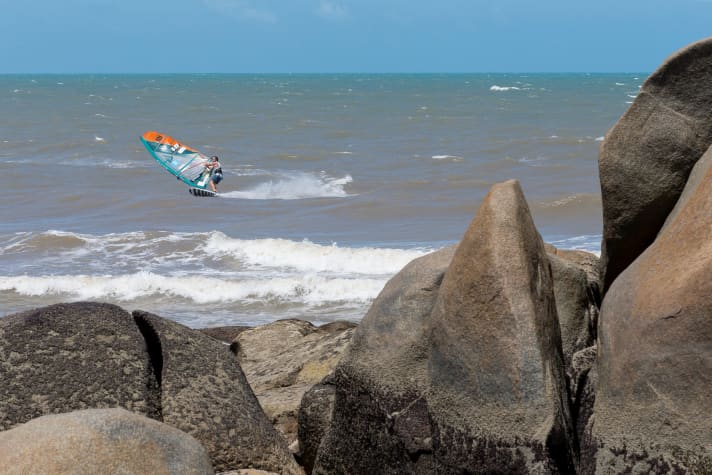
Downwind from Pedra do Sal, you can follow the coast for another twelve kilometres or so to the mouth of the Rio Parnaíiba. However, an off-road vehicle is important, as the unforgettably beautiful downwinder along the deserted sandy beach ends abruptly and irrevocably at the mouth of the southernmost of the five arms of the Rio Parnaíba.
7 ParnaÍba Delta
The Rio Parnaíba is one of the largest rivers in north-east Brazil. It rises in the interior of the country and flows into the Atlantic Ocean after 1,458 kilometres. On the last section, it divides the country with its tributaries into an exciting labyrinth of islands. The delta has 85 islands, of which Ihla Grande, Ihla do Paulino, Ihla Caju and Ihla Canarias are the largest. These islands can only be reached by boat from Porto das Barcas, around 15 minutes by car from Parnaíba.
The local fishermen have recognised the signs of the times and offer guided day trips to the individual islands. The boat trip through the breathtaking natural spectacle of mangroves, sand dunes and swamps is a highlight in itself. You can spot animals such as monkeys, turtles, caimans and storks. After an hour, you reach the estuary, one side of which is protected from the tides by a sand dune about 800 metres long and 150 metres wide. This is where the boats unload their passengers and the only shade you will have during your entire stay on this headland is under a tent roof! It is therefore essential to take plenty of drinks with you so that this magnificent excursion does not turn into an ordeal.
However, if you have enough time, you can also organise a completely individual trip over several days and not only discover unknown spots, but also soak up the flair of this unique landscape. The trips through the mangroves alone are an absolute highlight. Downwind of the Ihla Canarias there are perfect smooth water conditions. Directly on the Atlantic, on the other hand, the waves can be up to three metres high in onshore winds!
Spot Info Brazil North
Travelling to Brazil
TAP flies from Munich, Düsseldorf, Frankfurt, Hamburg and Berlin to Fortaleza every Monday, Wednesday, Friday, Saturday and Sunday via Lisbon. AirFrance flies every Tuesday and Friday from Paris to Fortaleza with a direct flight. From there, tour operators such as Surf & Action Company organise a transfer that takes around 5 - 5.5 hours. Surf & Action currently has Jeri, Icaraizinho and Maceio in its programme, Sun + Fun also Jeri and Icaraizinho.
Wind, weather & neoprene recommendations
The basic wind in northern Brazil is the trade wind and blows constantly from the east from July to the beginning of January and increases continuously during the day due to thermal influences. The wind blows most strongly from August to October and then becomes somewhat weaker towards the end of the year. If you want to travel to the region from Camocin to Pedra do Sal, you definitely need a sail size smaller than in the region around Cumbuco and Paracuru! We were in the region from Camocin to Pedra do Sal in the second half of November and mostly used sail sizes of around five square metres.
You don't need a wind forecast, the wind is as good as guaranteed.
However, you don't need internet access for the wind forecast as the wind is almost guaranteed. We only checked Windguru sporadically because the wave forecast for Maceió was interesting to read. In our time, it was an 18(!) second period that gave us big days. According to our experience from a dozen or so trips to the Ceara and Piaui regions, the wind blows strongest from Jeri to Macapá. At the Luis Correia and Pedra do Sal spots, the wind is a few knots weaker. The air temperature during the day is around 30 degrees and the water temperature is 27 degrees. A wetsuit is not necessary, but lycra is very useful as sun protection.
Stations
The Sa Barra Brasil centre is owned by the Italian Gigi Madeddu, is open from June to February and offers RRD surf equipment for hire, storage facilities for your own equipment and a small surf shop with spare parts. Website: www.sabarra.it
Living
During the high season in October and November, you should book accommodation in advance. However, you can also look on site and almost always find something. We found very nice pousadas with the Pousada Titas and the Barra Grande Kite Camp in Barra Grande ( www.pousadatitas.com.br , www.barragrandekitecamp.com.br ).
Food
We have repeatedly referred to restaurants in our descriptions. However, if you are on a budget, you can also eat out in the Brazilian barracas. These are usually located directly on the beaches and offer freshly caught fish with rice and salad for under ten euros.
Car hire
Jeff Stone from www.cumbuco-car-rental.com . We ordered the hire car to the airport in Fortaleza at our arrival time and Jeff Stone, who speaks good English, is standing at the exit with a name sign. This works very well and the hire cars are in good condition. Alternatively, you can book a shuttle from the airport to the spots or from spot to spot with the tour operator.
Money
Exchange ratio 1 euro = 5.4 reais, as at November 2023
Crime
We are often asked about safety in Brazil. It is considered safe in the country and at the surf spots during the season. We move freely and safely in these places, although we make sure that we get out of the airport in the metropolis of Fortaleza and into the countryside. There is an obvious police presence in all the coastal towns we visit.
This Spot Guide first appeared in surf 1-2/2022
